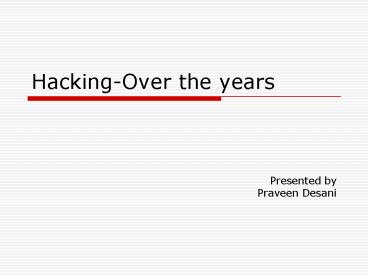HackingOver the years - PowerPoint PPT Presentation
1 / 24
Title:
HackingOver the years
Description:
Decryption using dictionary, brute force attack. 4. Replay attack. No need to decrypt. ... There are different rules and regulations in the situation of drug release. ... – PowerPoint PPT presentation
Number of Views:33
Avg rating:3.0/5.0
Title: HackingOver the years
1
Hacking-Over the years
- Presented by
- Praveen Desani
2
Overview
- Importance of security.
- Hacking.
- Methodologies.
- Motives.
3
Importance of Security
- Computers and internet are becoming pervasive.
- Consequence of being online.
- It has become a part of product design,
developing and deployment.
4
Importance of Security
- There are even organizations which provide
Security as a service - We need to know how computer attacks are
performed.
5
Hacking
- Clever programmer.
- Modification of a program/device to give user
access to features that were otherwise
unavailable to them.
6
Hacking
- Its usually a technical activity.
- SCRIPT KIDDIES
7
Attacking Methods
- Intrusion
- Physical Intrusion
- usually internal employees eg., booting with
floppy or taking the system part physically - System Intrusion
- low level privilages
- Exploit un-patched security vulnerabilities.
8
- Remote Intrusion
- Valid account names/Cracking weak passwords
- Exploiting common security vulnerabilities
(buffer overflow).
9
What it takes for an attack?
- Need to carry out some information gathering on
the target. - Plan their way into the system.
- Reduce chance of getting caught.
- During all these procedures, Network traffice
would look normal.
10
Pattern they follow
- 1. Foot printing.
- Getting complete profile and security
arrangements - Information of interest including the
technology the use (like internet, intranet,
remote access) - Security policies and procedures.
- 2. Network Enumeration.
- Attacker tries to find out domain names
and associated Networks related.
11
Pattern they follow.
- 3. DNS Interrogation.
- After NE is done , query the DNS.
- Revealing info about the organizations.
- Zone Transfer Mechanism.
- Leak of private DNS information.
- 4.Network Reconnaissance.
- Identifying the potential target.
- Try to map network topologies and identify
paths. - Eg trace route program
12
- 5. Scanning
- Knocking the walls.
- Which systems are alive and reachable?
- Ping sweeps, port scans, automatic
discovery tools. - At this point IDS warns, but not yet
attacked.
13
Unauthorized Access
- 1. Acquiring passwords.
- 2. Clear Text Sniffing.
- There is no encryption of passwords with
protocols like telnet, FTP, HTTP. - Easy for attackers to eavesdrop using
network protocol analyzers to obtain password. - .
- 3. Encryption sniffing.
- How about encrypted passwords?
- Decryption using dictionary, brute force
attack
14
- 4. Replay attack.
- No need to decrypt.
- Reprogram the client software.
- 5. Password file stealing.
- /etc/passwd in Unix
- SAM in WinNT
- Steal these files and run cracking
programs. - 6. Observation.
- Usage of long and difficult to guess
passwords. - Attackers with physical access.
- Shoulder surfing.
15
- 7. Social Engineering.
- Cracking techniques that rely on weakness in
users - ie., admin, operators.
- Calling up systems operator posing as a
field service technician with urgent access
problem. - 8. Software Bugs.
- Vulnerabilities brought by bugs in S/W
- Buffer overflow are found by
- buffer vulnerabilities on certain
programs. - Searching for these bugs
directly. - Examining every place the
program prompts for input and trying to
overflow it with random data.
16
Whats the need to learn?
- Does it help? Yes
- Developing more efficient ways to protect the
system.
17
Motives
- 49 -- discovery learning, challenge,
knowledge and pleasure - 24 -- recognition, excitement
- (of doing something illegal)
- 27 -- self-gratification, addiction,
espionage, theft and profit. - Addiction and curiosity.
18
How have they grown over the Years??
- 1st Generation
- Talented techies, programmers and Scientists
- (mostly from MIT )
- 2nd Generation
- Forward thinking to recognize the potential
of computer niche. - 3rd Generation
- Young people who used PC and entertainment
value of PC and began developing games(illegal
copying,cracking the copy right protection)
19
- 4th Generation
- Criminal Activity
- Claim that motivation was curiosity/hunger
for knowledge.
20
Types of Hackers
- White Hack
- Focusing on securing IT systems.
- Have clearly defined code of ethics.
- Improve discovered security breaches.
- .Tim-Berners Lee..
- Grey Hat
- no personnel gain, no malicious intentions.
- testing and monitoring.
- Black Hat
- crackers/they are criminals.
- maintain knowledge of vulnerabilities.
- Doesnt reveal to general
public/manufacturing for corrections.
21
What needs to be done?
- Intrinsically and Globally imperfect.
- There are many holes(not just technical ones)
- They also stem from bad-security practices and
procedures. - Educating the users, Security
Administrators - Securing the Environment
22
Comments/questions??
23
Discussion.
- Whom to blame?
- Who should be liable?
- Should government step in and regulate?
- Is it upto the individual computer users and
companies to stay on top of technology? - Should we blame the software industry for
selling insecure products?
24
Whom to blame?
- Lack of liability?
- Building a security product with no liability
is of no use. - Eg.,
- There are different rules and regulations in
the situation of drug release. - But Are there any regulations and rules in a
Software Release??
















![Contact {[{969:090:0054}]} 1 year MBA degree in India–MIBM GLOBAL PowerPoint PPT Presentation](https://s3.amazonaws.com/images.powershow.com/8832404.th0.jpg?_=201705050112)


![Get easy 1 year MBA degree in India Call {[969^090^0054]} MIBM GLOBAL PowerPoint PPT Presentation](https://s3.amazonaws.com/images.powershow.com/8832408.th0.jpg?_=20170505020)



![(MIBM GLOBAL ) 1 year MBA degree in India {[969-090^0054]} Number PowerPoint PPT Presentation](https://s3.amazonaws.com/images.powershow.com/8832396.th0.jpg?_=201705050111)







